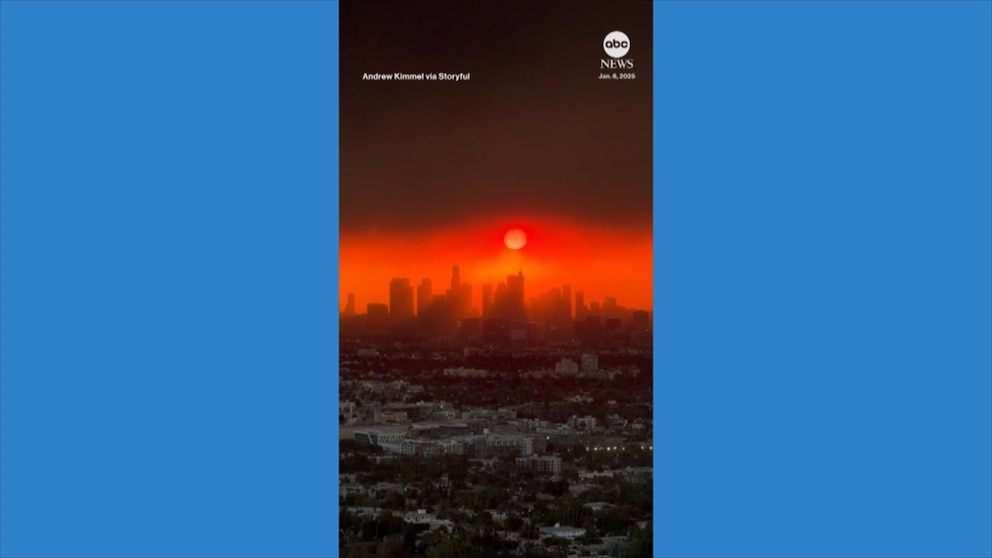Ghostly Veil: How Wildfire Smoke Transforms Los Angeles Skyline
The stunning skyline of Los Angeles has always been a source of pride for its residents, showcasing a blend of modern architecture and natural beauty. However, a thick haze from nearby wildfires has recently enveloped the city, creating a surreal and haunting scene. This transformation, often described as a “ghostly veil,” has not only altered the aesthetic of the skyline but has also raised significant concerns about air quality, public health, and the broader implications of climate change. As residents grapple with these effects, the reality of our changing environment looms larger than ever.
The Immediate Impact of Wildfire Smoke
Wildfires are an annual occurrence in California, but their intensity and frequency have escalated in recent years. As flames rage across the dry brush of nearby hills and forests, the resulting smoke drifts into the Los Angeles basin, casting a smoky pall over the city. This phenomenon has immediate and tangible effects:
- Reduced Visibility: The smoke creates a dense haze that obscures the view of iconic landmarks such as the Hollywood Sign and Griffith Observatory, making the skyline appear ghostly and ethereal.
- Health Risks: Wildfire smoke contains harmful pollutants that can exacerbate respiratory conditions, including asthma and chronic obstructive pulmonary disease (COPD). Vulnerable populations, such as children and the elderly, are particularly at risk.
- Disrupted Daily Life: Residents often find themselves confined indoors, with air quality advisories urging them to limit outdoor activities. This disruption can affect mental health and overall well-being.
The Ghostly Transformation of the Skyline
As the smoke settles over Los Angeles, the skyline takes on an eerie beauty that is both captivating and unsettling. The iconic cityscape, usually vibrant and colorful, is muted under the grayish-brown veil of smoke. The sun appears as a dim orb, casting an otherworldly glow over the buildings.
Photographers and artists alike have been drawn to this transformation, capturing the haunting vistas that emerge from the haze. Some describe it as a *melancholic beauty*, a stark reminder of nature’s power and the fragility of urban life in the face of environmental change.
Climate Change: The Underlying Cause
The wildfires that contribute to this ghostly veil are not simply a result of natural cycles; they are increasingly influenced by climate change. Rising temperatures, prolonged droughts, and changing precipitation patterns have created conditions ripe for wildfires to ignite and spread. According to the NASA Earth Observatory, California has experienced an increase in the number and severity of wildfires over the past few decades, a trend that scientists attribute to climate change.
This correlation raises critical questions about the future of Los Angeles and other vulnerable regions. As climate change continues to intensify, residents must confront the reality that such ghostly transformations may become more frequent and severe.
Community Resilience and Adaptation
While the effects of wildfire smoke can be daunting, the resilience of Los Angeles residents shines through. Communities are coming together to address the challenges posed by air quality issues and climate change. Initiatives include:
- Community Awareness: Local organizations are working to educate residents about the health risks associated with wildfire smoke and the importance of preparedness.
- Improved Infrastructure: The city is investing in better air filtration systems for public buildings, including schools and community centers, to provide safe havens during smoke events.
- Advocacy for Climate Action: Grassroots movements are pushing for policies that address the root causes of climate change, advocating for sustainable practices and renewable energy sources.
Long-Term Solutions and Environmental Stewardship
Addressing the challenges posed by wildfires and their impact on the Los Angeles skyline requires a multifaceted approach that goes beyond immediate response measures. Long-term solutions must focus on environmental stewardship and sustainable land management practices:
- Forest Management: Proactive measures such as controlled burns and forest thinning can help reduce the fuel load in fire-prone areas, decreasing the likelihood of catastrophic wildfires.
- Urban Planning: Thoughtful urban planning that incorporates green spaces can help mitigate the urban heat island effect, making cities more resilient to climate change.
- Community Engagement: Engaging local communities in conservation efforts can foster a sense of stewardship and responsibility for the environment.
The Role of Technology and Innovation
In the fight against wildfires and their effects, technology plays a crucial role. Innovations such as satellite monitoring and predictive modeling are being employed to track fire activity and assess air quality in real-time. This data empowers residents and officials to make informed decisions during wildfire events.
Moreover, advancements in clean energy technology can help reduce greenhouse gas emissions, addressing one of the primary drivers of climate change. As the world moves towards a more sustainable future, Los Angeles can be at the forefront of these efforts, showcasing how urban environments can adapt and thrive amidst environmental challenges.
Conclusion: A Haunting Beauty with a Call to Action
The ghostly veil of wildfire smoke that transforms the Los Angeles skyline serves as both a haunting reminder of our changing climate and a call to action for residents and leaders alike. While the immediate effects can be disorienting and even frightening, they also inspire a sense of community resilience and a drive for sustainable solutions.
As we navigate the complexities of climate change and its impact on our cities, it is imperative that we come together to advocate for policies and practices that protect both our health and our environment. The surreal beauty of a smoke-filled skyline can prompt reflection, but it must also spark a commitment to ensuring a healthier, more sustainable future for generations to come.
See more Your Daily Weather



